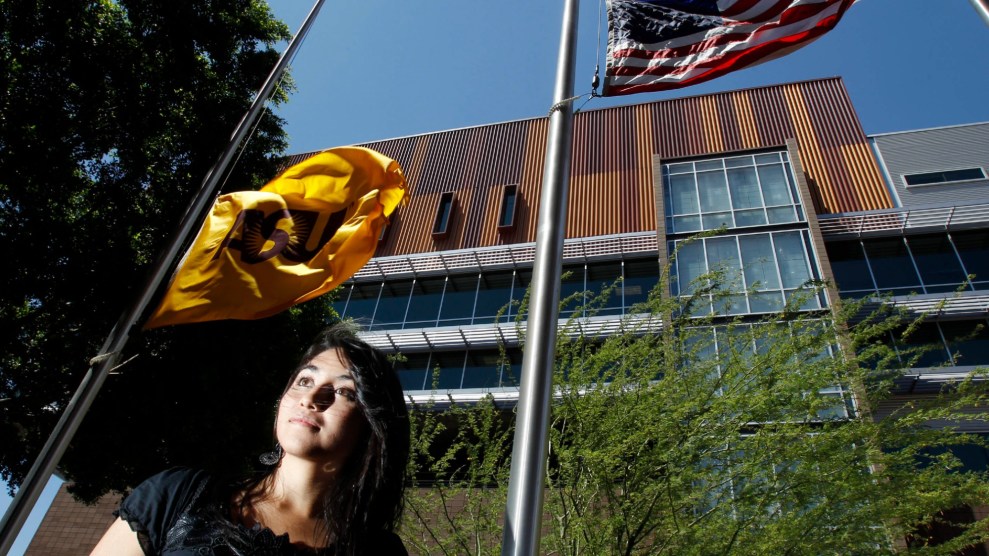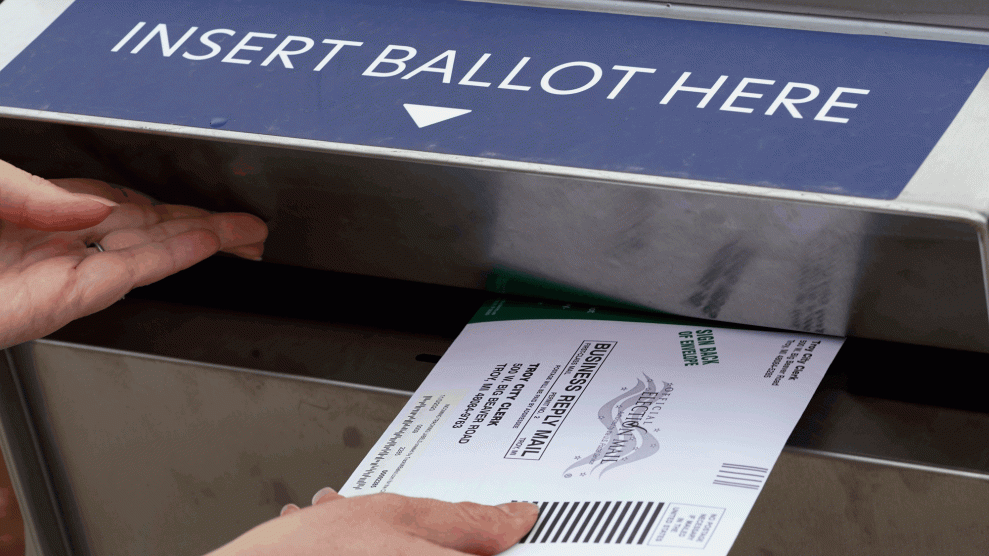
Angelica Hernandez poses for a photo at the Arizona State University campus.Ross D. Franklin/AP
Jose Patiño remembers how his mother cried when the acceptance letter from Arizona State University arrived in the mail in late 2006. There it was, the ultimate reward for her son’s hard work and the reason why they had sacrificed so much by leaving Mexico when he was six years old. He had not just been accepted, he received a full scholarship offer. Patiño was on the way to becoming the first member of his undocumented family to get a college degree. “I had never seen her that happy,” Patiño says.
But their happiness proved short-lived. A few months later, Patiño received a different letter from the university stating that his tuition had tripled, and he no longer qualified for the scholarship. That abrupt change was a direct result of Proposition 300, a successful ballot measure that made university students in Arizona who were not US citizens or permanent residents and those lacking legal status ineligible for in-state tuition and federal and state financial aid. The referendum was approved with 72 percent of votes in November 2006. “I’m going to figure out a way,” Patiño told his mother at the time. “It will be difficult, but I’ll figure it out.”
Patiño, now the education and external affairs director of the Arizona-based immigrant youth-led group Aliento, did figure it out. He went on to attend ASU on a private scholarship set up by university administrators sympathetic to the plight of undocumented students in Arizona. He received a bachelor’s degree in mechanical engineering, and then a master’s degree in secondary education from Grand Canyon University. But the impact of Proposition 300 was profound. A 2011 analysis by ASU’s Cronkite News found that between the Spring of 2007 and the Fall of 2010, the number of students without proof of citizenship in public universities in the state plummeted from 1,524 to 106. Proposition 300 effectively made college education unattainable for many of Arizona’s low-income undocumented youth.
Sixteen years later, that could change. The majority of voters in Arizona during the recent midterm elections were in favor of Proposition 308, a ballot measure that repealed provisions from Proposition 300 and opened the way for any high school graduate, regardless of immigration status, living in Arizona for at least two years, to access in-state tuition rates at state universities and community colleges. By some estimates, as many as 3,600 students might benefit from the policy every year. The successful ballot measure received 1,250,319 “yes” votes—or about 51 percent—a little shy of the 1,287,890 votes received by Gov. Katie Hobbs. That result puts Arizona alongside 22 other states and the District of Columbia that allow undocumented students to pay tuition on par with their US-born peers.
“The beauty and the pain of this campaign,” says Patiño, who worked on the legislative proposal referring Proposition 308 to the ballot, “is that the people advocating, finding sponsors for the bill, getting the legislature to pass it, and talking to voters were the same people [Proposition 300] was intended to bury.”
Considering its long history of policies and legislation openly hostile to immigrants and Latinos, Arizona would seem an unlikely place for a pro-immigrant measure to succeed. Indeed, Proposition 300 was only one of a series of restrictive proposals aimed at excluding and punishing foreign-born people that appeared in the early 2000s. Such efforts fell under what became known as “attrition through enforcement,” a harsh anti-immigration strategy championed by Kansas Attorney General Kris Kobach and once supported by then-presidential hopeful Mitt Romney. Its basic premise was to make the lives of undocumented people in the United States so miserable they would simply leave, or “self-deport.”
Between 2004 and 2006, voters in Arizona approved ballot measures requiring proof of citizenship to register to vote and access state and local public benefits. One initiative denied bail to people charged with felonies and believed to have entered the country without authorization, and another made English the state’s official language and prohibited undocumented immigrants who won civil lawsuits from receiving punitive damages. “You are not going to come to America and get some lottery payout,” said then-Republican State Rep. Russell Pearce, who had been the main force behind most anti-immigrant initiatives in the state.
That anti-immigrant drive in Arizona reached its apex in 2010 with one of the most, if not the most, draconian legislation in the country. Informally known as the “show me your papers” law, SB 1070 required law enforcement to ask for proof of legal status if they suspected someone was undocumented. It also gave police the authority to arrest, without a warrant, those they believed to be “deportable.” That same year, Republican Gov. Jan Brewer signed a law, later ruled unconstitutional, banning a Mexican-American studies program in the Tucson school district.
By then, Pearce, who authored SB 1070, was Arizona’s senate president and largely regarded as the most powerful politician in the state. Although the Supreme Court partially struck down the racial profiling legislation in 2012, it nevertheless made Arizona ground zero in the war on immigrants and spurred concerns of an “Arizonification of America” with other states enacting copycat laws.
But how did Arizona become what the former Daily Show host Jon Stewart called “the meth lab of democracy”? Kristina Campbell, a professor at the University of the District of Columbia-David A. Clarke School of Law who lived in Arizona in the early 2000s, argues that it was a combination of “power, corruption, and white supremacy.” She had a thorough exposure to all three in her previous job. Prior to the passage of SB 1070, Campbell had worked as a staff attorney for the Mexican American Legal Defense and Educational Fund (MALDEF), a Los Angeles-based Latino legal civil rights organization. “What I did most was sue Sheriff Joe Arpaio,” she says. “I mean, talk about a reign of terror.”
Arpaio, an immigration hard-liner and self-proclaimed “America’s toughest sheriff,” ruled over Maricopa County, Arizona’s most populous county, for more than two decades. (Pearce served under Arpaio as chief deputy.) He became notorious for housing inmates in so-called tent city jails in the desert and conducting discriminatory sweeping raids and traffic stops targeting Latinos. In 2017, a federal judge convicted Arpaio of criminal contempt after he violated a court order to stop the racial profiling practice. Soon after, the disgraced sheriff became the first person to be pardoned by one of his biggest fans, then-President Donald Trump.
Patiño has memories of the climate of fear while he was growing up. He would see signs on buses with a number to call to report unauthorized immigrants. Or he would hear alerts on the radio about the location of immigration enforcement checkpoints so people could avoid them. “You can’t let your guard down,” he says, describing a survival mode mindset that became normalized because “everyone you know is going through it.” But all those years of relentless assault on immigrants and Latino communities took a toll and ignited a movement. “There was a lot of crying all the time,” he says. “We came out of the shadows because we were tired of being afraid.”
The passage of SB 1070 served as a catalyst for change. Perhaps the best indication of that came in late 2011 with the once unimaginable ousting of Pearce, the first-ever Arizona legislator to be recalled. Voters rejected him with 55 percent of votes in a recall election interpreted, as the New York Times put it, “as a sign that Republican politicians like Mr. Pearce were pushing too far with their get-tough approach to illegal immigration and that there were consequences if they did not get in sync with voter concerns.”
In describing the historic campaign spearheaded by organizer Randy Parraz, Jeff Biggers, the author of the 2012 book State Out of the Union: Arizona and the Final Showdown Over the American Dream, said in an interview for Democracy Now!, “There was this new generation of young Latinos willing now to work with these new Baby Boomers who were retiring in Arizona and come together and take on extremism and win.” They represented, he noted, the rise of the “other Arizona,” one that posed resistance to the “headline-grabbing nativists, frontier justice sheriffs, neo-Nazi marchers, gun-toting militiamen, and Tea Party political figures.” And they won again when Arpaio lost his reelection bid in 2016. At the age of 90, he tried to make another comeback this year running for mayor of 25,000-people Fountain Hills—but he was defeated by two-term Democratic incumbent Ginny Dickey.
“Why has this change happened and why has it happened so relatively fast?” asks Campbell. “I have to give credit to the young generation that is not afraid to take on that type of intimidation, harassment, and discrimination. They have made some changes I never thought would happen in Arizona.”
For many, the idea of restoring in-state tuition and financial aid for undocumented students seemed to be a long shot. Reyna Montoya, the founder of Aliento, recalls people laughing at the idea. “They didn’t think this was possible,” she says. “We got pushback even from some organizations because they didn’t think the timing was right.”
The first step was for legislation to put the proposal on the ballot to be passed by the conservative Republican legislature. Previous attempts going back to 2018 failed to find a Republican legislator to sponsor the bill or even to get a hearing in the House. It wasn’t until 2021 that advocates were able to make progress, but not without reservations from both sides of the aisle. For some Democrats, the proposal didn’t go far enough as it didn’t constitute a full repeal of the original ballot initiative that additionally hindered access to adult education and childcare assistance. Meanwhile, Republicans pushed back against the financial aid provision. But in May 2021, the resolution introduced by Republican State Sen. Paul Boyer moved forward in the House on a 33-27 vote, with four Republicans supporting it.
“Wow, so we did it,” Boyer said at a press conference. “It’s a rarity when you can say you passed a piece of legislation that truly changes lives, and this bill changes about 2,000 lives every single year. We are standing on the shoulders of giants.”
Once the legislative hurdle was behind them, it was a matter of building on years of community organizing to educate voters about the initiative, which was one of 10 measures on the ballot. Most people Patiño and Montoya talked to in the lead-up to the election didn’t know access to in-state tuition for undocumented students was an issue, let alone one that they could vote on it. Patiño remained hopeful but skeptical until the last minute. “This is still Arizona and immigration is still a big issue,” he told me. “People are going to have camps already that they are going to be in because of the years and years of rhetoric that we have heard pro and anti. I knew it was going to be close.”
On November 14, a week after Election Day, the votes were finally counted and their victory became official. “It gives me a lot of hope that we can make big transformational changes for the community,” says Patiño. “It may take longer than we would want to, but we can do it.”











